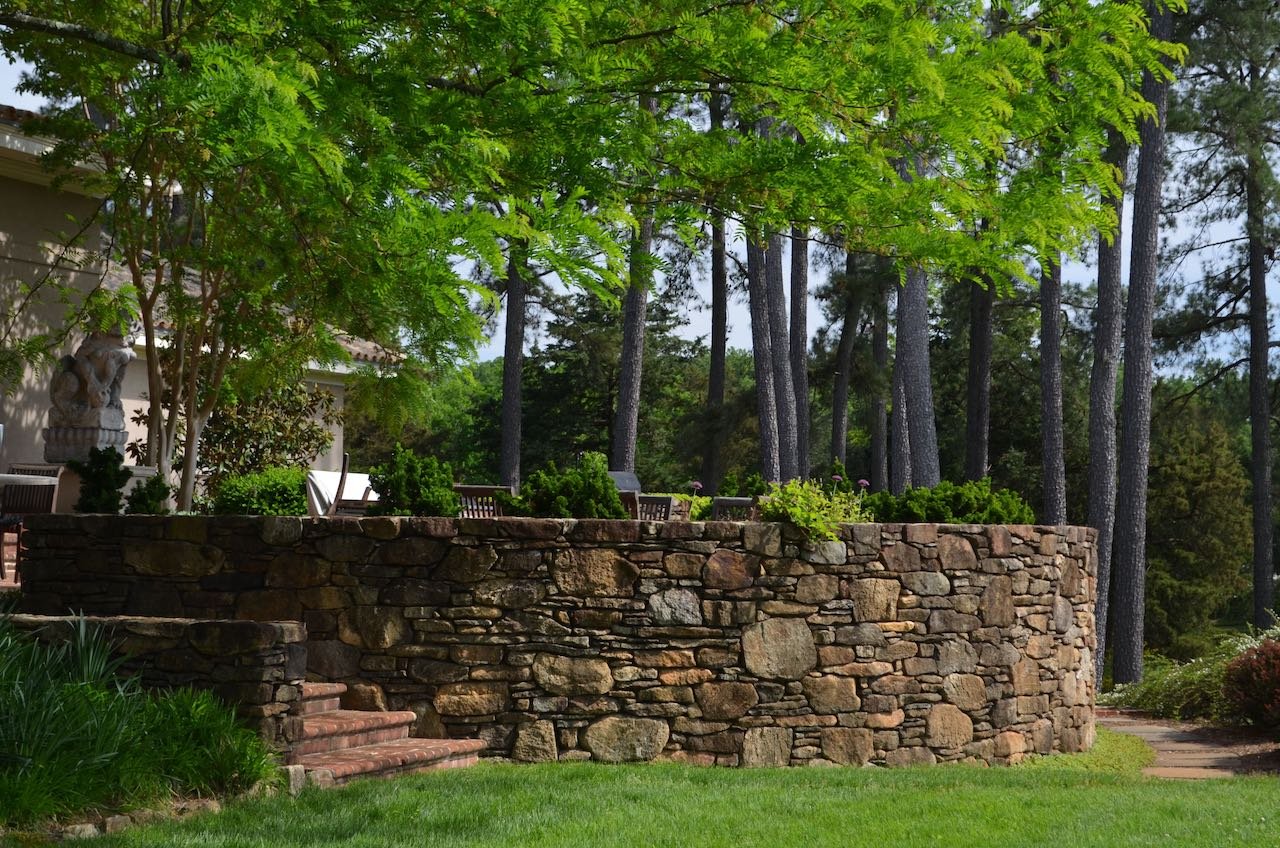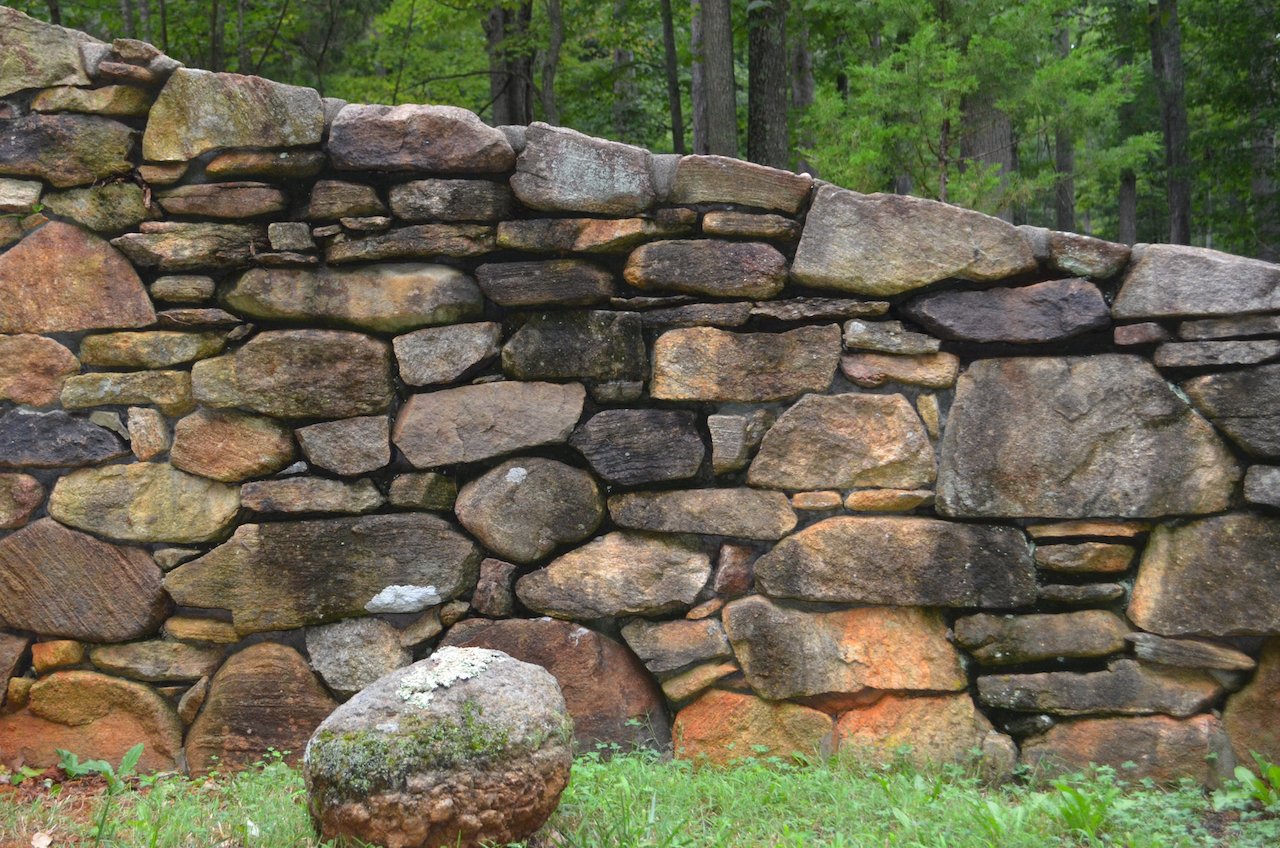Rebuilding miles of historic walls, stone by stone.
By Joan Tupponce

Stonemasons Shelton Sprouse and John Mack Apperson are often found in the thick of the woods trudging through briars and warding off bees and snakes as they collect the highest quality local stone for their projects. “There are some great stones here,” says Sprouse. “A lot of the locals buy stone from Delaware and Pennsylvania without realizing how beautiful our stone is. Everything we’ve used in our work at Monticello and University of Virginia was local stone that Jefferson would have had access to in his own time.”
The two friends, who specialize in building authentic recreations of historic stonework, received an American Institute of Architects award in 1991 for their work at Thomas Jefferson’s Monticello and Poplar Forest, as well as the stonework at James Monroe’s Highland (formerly known as Ash Lawn). Their work at UVA includes a garden at Carr’s Hill, the school president’s residence, built in collaboration with landscape architect M. Meade Palmer. They also do a great deal of contemporary stonework for clients such as best-selling author John Grisham and Stefan Lessard, the bassist for the Dave Matthews Band.
The key to their success is hard work and dedication to their craft, says Apperson, 67. “We work every day the weather permits. We have to adapt to weather conditions in order to have our projects finished in time.”
Taking a day or week off is rare unless the weather prohibits the pair from working outside. Holidays are usually workdays. “I remember Johnny said he had to take off a half-day on a Tuesday. I asked him why and he said he was going to get married. He was back to work the next day,” Sprouse, 69, recalls with a hearty chuckle.

The two men met during their early childhood, when they lived in downtown Crozet and were next-door neighbors, Sprouse says. Both worked in construction prior to joining forces. Sprouse opened his business in 1971, and Apperson came to work with him in 1976. They learned to be stonemasons by researching the ancient stonework of the Incas, Egyptians, and Romans, and also by tearing down old stone masonry. “It was a great education,” Sprouse says, adding that when they tore down old masonry they could “see what was wrong in the technique.”
The pair only used the techniques favored by the ancient stonemasons in their own work. “The Romans were the most incredible stone constructors,” Sprouse says. “They were the most innovative. They did some stunning things.”
Their big break came when they got a call from the Thomas Jefferson Foundation in 1980. “We worked continuously with them on Monticello for several years,” Sprouse says.

The project was massive and “complicated,” says Peter J. Hatch, who served as the director of gardens and grounds at Monticello from 1977 to 2012. Hatch was heavily involved in the restoration of Thomas Jefferson’s 1,000-foot-long garden and 400-tree orchard.
A huge structure, the wall was 16 feet tall in places and one-fifth of a mile long. “The task required that Shelton duplicate the subtle but sometimes ragged construction of the original structure, including its capstones, an unusual double wall in sections, the way rock was knitted together and organized by shape and size, and the nature of the supporting rubble fill stone behind the wall,” Hatch says, noting the wall had to be strong enough to support the reconstruction of Monticello’s garden pavilion. “This required an astute interpretation of the archaeological remains.”
A team of archeologists worked in three phases to remove artifacts as Sprouse and Apperson moved along the wall, which they finished in 1983. “Johnny found a basket full of broken china behind the original wall. The archeologists said we found some of the best artifacts,” Sprouse says.

The two completed several other projects at Monticello. Those included building a wall around the Levy gravesite and recreating the north privy, as well as supplying 440 tons of handpicked Albemarle County fieldstone for the construction of a new visitor’s center. “We didn’t build it; we just supplied the stone,” Sprouse says of the center.
At work, Sprouse labors with the “religious calm of a Zen master,” observes Hatch. That calm reflects Sprouse’s many years of practicing yoga as as the owner of Blue Moon Yoga in downtown Waynesboro. And, the flexibility that yoga promotes helps Sprouse with his work. “Yoga is essential,” he says. “With it, I have been able to stay strong and flexible.”
After all these years, Sprouse and Apperson still work with the same dedication they had at the beginning of their journey. It continues to be quite a ride, Sprouse says. “We stay really busy, and I’m super proud of what we have done together.” SheltonSprouse.com
